Apple's 2010 MacBook Air (11 & 13 inch) Thoroughly Reviewed
by Anand Lal Shimpi on October 26, 2010 10:08 PM EST- Posted in
- Mac
- Apple
- MacBook Air
- Laptops
The SSD: Not Half Bad
Apple advertises the new MacBook Air as being instant on as a result of the internal SSD. That’s mostly untrue. From a completely powered off state the MacBook Air still takes time to boot. That time is significantly reduced compared to the old MacBook Air and any other Mac with a conventional hard drive. It’s even a shorter boot than my MacBook Pro with a SandForce SF-1200 based SSD in it:
| System Performance Comparison | ||||||
| Boot | Shut Down | Sleep | Awake | |||
| 11-inch MacBook Air | 15.5 seconds | 2.2 seconds | 1.0 second | 1.63 seconds | ||
| 13-inch MacBook Air | 14.4 seconds | 1.9 seconds | 1.0 second | 1.56 seconds | ||
| 13-inch MacBook Air (Late 2008) | 34.4 seconds | 2.9 seconds | 1.6 seconds | 4.19 seconds | ||
| 15-inch MacBook Pro (SF-1200 SSD) | 19.1 seconds | 1.8 seconds | 1.5 seconds | 2.3 seconds | ||
| 15-inch MacBook Pro (Mid 2009, HDD) | 34.2 seconds | 2.8 seconds | 1.8 seconds | 2.1 seconds | ||
You'll notice that even the SF-1200 SSD in my 15-inch MacBook Pro takes longer to boot than these new Airs. Apple does customize the firmware on its SSDs. I’d be willing to bet the SSD in the MacBook Air has tight integration with OS X to guarantee quicker than normal boot times.
Clearly the new Air isn't instant on from a boot standpoint, but it's pretty much there from a recover-from-sleep standpoint. The new Airs both go to sleep and wake up from sleep quicker than any of the other Macs, including my upgraded 15-inch Core i7 MacBook Pro. Again, nothing can trump Apple's tight integration between hardware and software.
Apple likes to work with two different controller manufacturers for SSDs: Samsung and Toshiba. iFixit already confirmed Toshiba is in the new MacBook Air with its teardown:
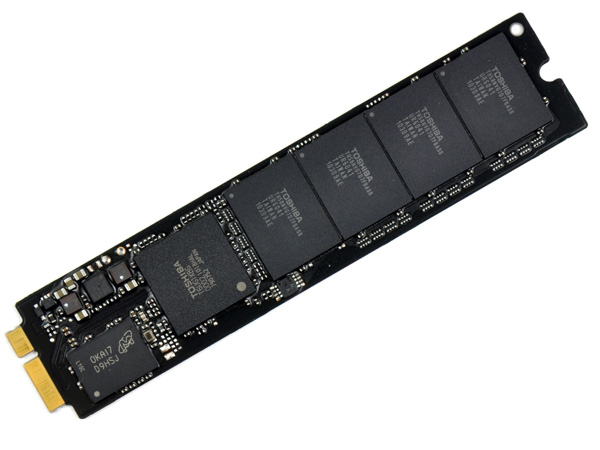
The 11-inch MacBook Air SSD, courtesy of iFixit
The SSD isn’t in an industry standard form factor, although the connector appears to be either micro or mini SATA. Presumably 3rd party SSD manufacturers (ahem, SandForce partners I’m looking at you) could produce drop in replacements for the MacBook Air SSD.
There’s nothing particularly innovative about the form factor of the SSD, other than Apple did away with the unnecessary space a 2.5” SSD would require. Just as SSDs will break the traditional SATA interface barriers, we’ll see the same happen to form factors as well.
The part number on the Toshiba controller may look familiar to some of you. It’s the same controller that’s in Kingston’s SSDNow V+ Series and the SSDNow V Series Boot Drive. I reviewed the latter not too long ago and found that it was a good drive for the money, and here’s the kicker: the SSDNow V Series Boot Drive was amazingly resilient when written to without TRIM support. Its performance hardly dropped as a result of normal desktop use. This is very important because although OS X 10.6.4 has a field for reporting TRIM support on an SSD, the instruction isn’t actually supported by the OS. Even the new MacBook Airs don’t ship with a version of OS X with TRIM support.
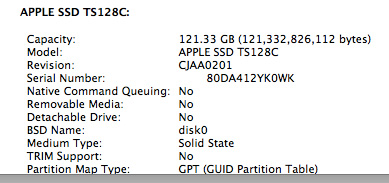
The SSD only has four NAND devices on it. Typically that would mean some very low transfer speeds, particularly on writes. But each one of those four devices has at least 16GB of NAND, spread across multiple planes and die. With the right firmware, you should be able to extract a good deal of parallelism from this architecture. Apple and Toshiba apparently do just that.

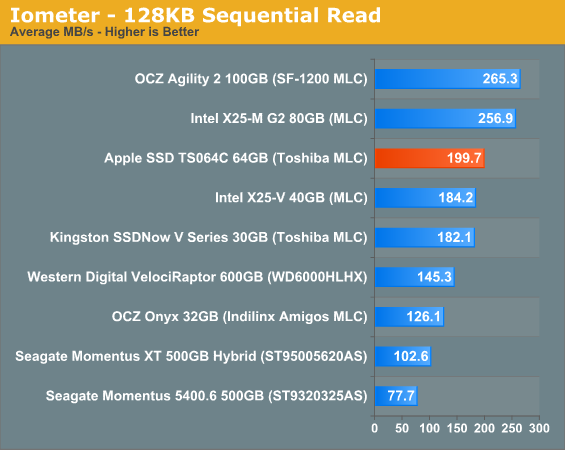
While most value SSDs top out at under 100MB/s, we get nearly 200MB/s sequential reads and writes out of the SSD in the new MacBook Air. And fortunately, Apple hasn’t only focused on sequential performance. The random read/write performance of the new MacBook Air SSD isn’t terrible:
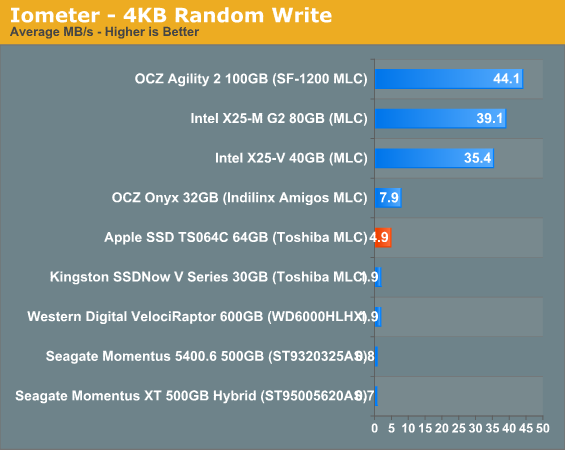
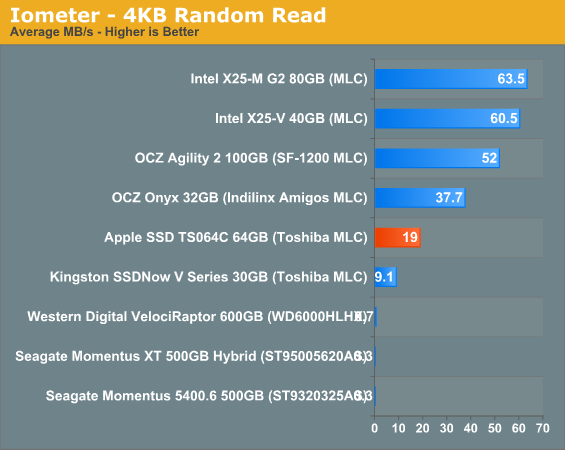
Random write performance is of course the weak point, but you’ll notice that it’s actually higher than the Kingston drive that uses the same controller. While Apple would’ve been better off striking a deal with Intel or SandForce for the controller in the MacBook Air, the Toshiba controller isn’t horrible.
As I mentioned earlier, resilience is very important as OS X still doesn’t support TRIM. I filled the drive with garbage and then tortured it for 20 minutes with random writes. The resulting performance drop was noticeable, but not unbearable:
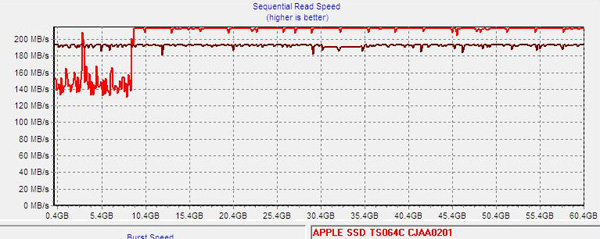
A single pass of sequential writes restores performance to normal:
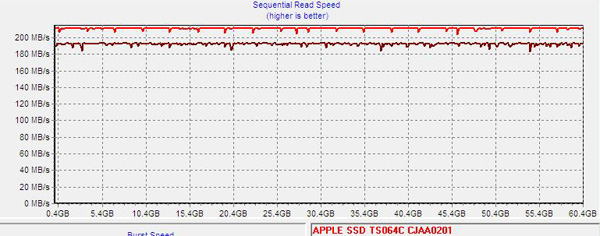
This tells us two things. First, through normal use the drive should be able to recover its performance over time (assuming you give it enough spare area). And second, if there’s any idle garbage collection in Apple’s custom firmware for the Toshiba controller it should be able to keep the drive running at peak performance even without TRIM supported in the OS. I don’t have a good way of measuring whether or not there’s GC enabled on the drive in OS X, but I suspect Apple is (at least it appears to be doing so on the Mac Pro’s SSDs).
Overall I’m pleased with Apple’s SSD selection. It could’ve been a lot better but it could’ve been a lot worse. The MacBook Airs in their default configuration have better IO performance than any other standard config Mac sold on the market today, including the Mac Pro.










185 Comments
View All Comments
iwodo - Wednesday, October 27, 2010 - link
Well i write a 100 word pieces but in the end i deleted it.Netbook is not an defined term anyway, so i wont bother arguging. Every one has different view on that is an notebook ultraportable and what is an netbook.
mcnabney - Wednesday, October 27, 2010 - link
FTA"For me, I’d have to own the 11-inch, plus a 15-inch MacBook Pro plus my desktop."
Ah yes, the $5000 total computing solution.
iwodo - Wednesday, October 27, 2010 - link
I am amazed that on one brought the question up. How could a MUCH faster MBP with faster CPU, and a FASTER SSD. ( Two important factor ) boot up slower then MBA?It even start application quicker then MBP when the SSD inside MBA is like 50 - 70% slower then Sandforce and Intel SSD.
When i read a pieces on techcrunch mentioning that MBA feels just as fast if not faster then MBP when browsing and doing most light weight working, i thought it was an biased review. When Macworld released a test result showing MBA is just as fast as MBP in day to day usage. I thought the the test was not thoughtful enough.
Now Anand has REAL numbers, and number of other reviewing showing the same results. It could not be false. A MUCH SLOWER SSD and a MUCH SLOWER CPU Wins!!!! How could this be possible?
Firmware Optimization? What exactly did they optimized? Why didn't this optimization show up in any of the IOMeter test or other Speed test? The Sandforce and Intel SSD Wins in EVERY SINGLE BENCHMARK test done.
I really hope Anand find this out.
tipoo - Wednesday, October 27, 2010 - link
I was wondering this too. Any insights?B3an - Thursday, October 28, 2010 - link
Yeah can we get an answer on this??iwodo - Thursday, October 28, 2010 - link
No one is putting out the questions? It seems people are more interested in what is bargain priced, what is better value of hardware, and what is an netbook more then the technical aspect of an SSD.blufire - Thursday, October 28, 2010 - link
Keep in mind that the chipset is different. MBA is using the NVIDIA GeForce 320M while the 15" MBP is using the associated Intel chipset.iwodo - Saturday, October 30, 2010 - link
Then it would have effected the outcome of benchmarks. The point is, it didn't. And a MBA SSD still perform the bestpieterjan - Wednesday, October 27, 2010 - link
Why is there an SD card reader? There are a lot of camera's that won't work with SD cards. Replace it with 2 extra USB ports! For those who actually need a card reader: how much does a 9000-in-1 USB reader cost? $15? Or better yet: make it an Apple accessorie at $ 50...crimson117 - Wednesday, October 27, 2010 - link
<blockquote>For me, I’d have to own the 11-inch, plus a 15-inch MacBook Pro plus my desktop. That’s three machines, plus a smartphone and I’d be set. I’d carry the 11-inch on most business trips, the 15-inch for big shows that I’d have to cover and any heavier work I’d do at home on the desktop. I don’t mind the setup, it’s just a costly setup to have.</blockquote>How do you keep all your data in sync across those machines?